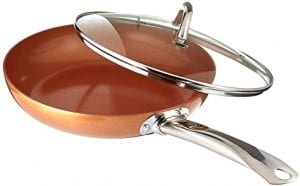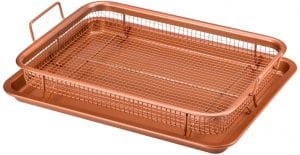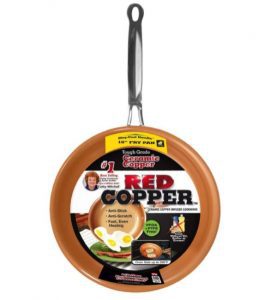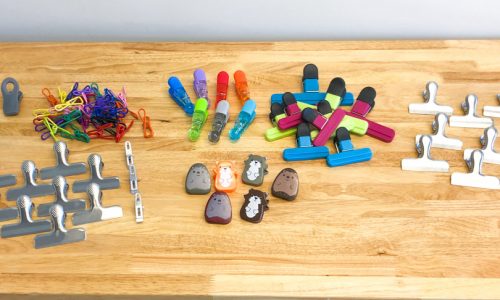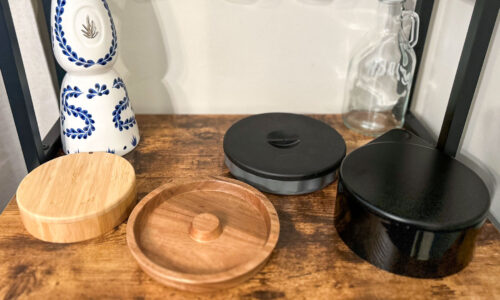The Best Copper Cookware
We looked at the top 14 Copper Cookwares and dug through the reviews from 202 of the most popular review sites including and more. The result is a ranking of the best Copper Cookwares.

Our Review Process
Don't Waste Your Money is focused on helping you make the best purchasing decision. Our team of experts spends hundreds of hours analyzing, testing, and researching products so you don't have to. Learn more.
Our Picks For The Top Copper Cookwares
- 1. SHINEURI Quick Heating Kitchen Copper Cookware, 5-Piece
- 2. Moss & Stone Multi-Use Easy Clean Copper Cookware, 5-Piece
- 3. Copper Chef Oven-Safe Copper Cookware, 10-Inch
- 4. Gotham Steel Ti-Cerama Coated Copper Cookware, 10-Inch
- 5. Copper Chef Induction Plate Copper Cookware Set, 9-Piece
- 6. Copper Chef Eco-Friendly Copper Cookware Set, 9.5-Inch
- 7. KUTIME Nonstick Ceramic Coating Copper Cookware, 6-Piece
- 8. BulbHead Nonstick Copper Cookware, 10-Inch
- 9. Copper Chef Air Fry Mesh Basket Cooper Cookware, 13-Inch
- 10. Copper Chef Non-Toxic Copper Cookware Set, 12-Piece
- 11. Gotham Steel Kitchen Set with Non-Stick Coating, 10-Piece
- 12. BulbHead Copper Induction Compatible Ceramic Cookware, 10-Piece
- 13. Red Copper Anti-Flaking Copper Cookware, 10-Inch
- 14. Gotham Steel Nonstick Frying Copper Cookware, 8.5-Inch
Even heat distribution is what you'll get from this copper cookware, which means no more burnt edges and cold centers. The set includes two frying pans, a sauce pot and two glass lids, making it ideal for individuals just starting out in their own apartment or home. Of course, the biggest draw to this set is the nonstick surface, as you'll only nee...
Great Starter SetUse this copper cookware set on ceramic glass, electric, induction and gas cooktops.
Whether you enjoy frying chicken or Oreos, this copper cookware set has you covered. It includes a deep nonstick pan with fry basket, steamer rack and glass lid. The cookware is also safe for induction stovetops, in addition to electric and gas ranges.
Three Available FinishesYou'll find this copper cookware set comes in a choice of red, black and copper finishes.
The handles on this copper cookware are sturdy and suitable for high-heat ovens. The nonstick surface is very slick and safe for ovens or dishwashers.
Safe, Sturdy FryerThis copper cookware is oven- and dishwasher-safe.
You'll be pleasantly surprised by this copper pan, as it's both lightweight and durable. Thanks to the pan's solid aluminum construction, heat is distributed evenly throughout the pan. Each purchase comes with a matching glass lid with upper metal handle.
Lightweight and DurableThis copper cookware is equipped with a coating that eliminates the need for butter or oil.
Buying Guide
When you’re talking about cookware, looks don’t generally figure into the equation. Those good old stainless steel pots and pans in our cabinet are there to get the job done, not to impress anyone. But there are a couple of types of kitchenware that make any bystanders take notice; pieces that say, “I’m not warming up casserole tonight.” One of those is cookware made from copper.
With its distinctive brushed-gold shine, copper cookware certainly looks expensive, and it can be. Prices vary greatly, but a well-made set might run double or triple what you’d pay for stainless steel.
Mind you, you’re not just paying for that shine. Far from it: Copper has a lot of unique advantages (and a couple of quirks), but its biggest one is best summed up by Julie Chernoff, dining editor for the lifestyle magazine Better: “What makes it great: conductivity. It heats up both quickly and evenly, but that also means it doesn’t retain heat and cools off quickly.”
This mercurial property makes it particularly well-suited to sauces, sugary substances, veggies or delicate proteins, allowing a nimble cook to control their temperature on the fly. For things like steak, you’ll want a cast-iron pan that might heat up slowly but will retain that heat well. For sauteed onions or a good risotto? There’s nothing quite like copper in the hands of a capable chef.
The even heat distribution of copper makes it relatively non-stick, but you’ll typically find copper cookware coated with another substance. That’s because copper does tend to react with tomatoes, citrus and other acidic foods, imparting a funky taste. It might also leach into other foods at high temperatures, and while copper is a naturally occurring substance, too much of it can be toxic. Mind you, sugars will negate the reaction associated with acidic foods, which is why you’ll find certain saucepans and sugar pans made of naked copper to take full advantage of their properties. The Copper Chef Square Frying Pan With Lid, 9.5-Inch and the Gotham Steel Nonstick Griddle Pan, 10.5-Inch both boast a plus-size cooking space, perfect for creating large confections.
These days, though, you’ll find most copper cookware is lined with stainless steel. As far as conductivity goes, a small layer won’t affect the heat transfer much, although you might have to crank up your temperatures slightly. Stainless steel usually lacks the natural nonstick qualities of copper as well. On the other hand, it’s a lot more durable. Copper surfaces scratch easily with metal utensils, which is why you’ll want to use wooden or plastic spoons. With stainless steel, there’s no such need. It’s also rustproof and (as the name implies) won’t discolor with age.
Tin used to be the metal of choice for lining copper pans, although it’s much less common. It’s a somewhat better conductor than stainless steel and works fine with acidic foods, but it is much less durable, prone to discoloration and has a relatively low tolerance for high temperatures.
You might find linings on the underside of copper pans for a completely different reason: Induction cooking. Induction stoves work by passing an electrical current through the pots or pans on top of it, and while copper conducts heat like a champ, it doesn’t do so well with electricity. Some copper pans, like the Copper Chef Round Pan Copper Cookware Set, 9-Piece, might incorporate a metal lining on the base to counteract that. Definitely something to look for if you have an induction stove.
Our Expert Consultant

Culinary Expert
Julie Chernoff is a long-time member of Les Dames d’Escoffier (past president of the Chicago Chapter, and current co-chair of the LDEI Legacy Awards Committee), the Association of Food Journalists (AFJ) and the International Association of Culinary Professionals.
Chernoff is the dining editor of Better, a lifestyle website and print magazine. Her journalism started in the test kitchens of Weight Watchers Magazine. She holds a BA in English from Yale University and is a graduate of the California Culinary Academy. She has spent the last few decades styling, photographing, teaching, developing recipes, editing, thinking and writing about food.
Why we recommend these copper cookwares?
Products Considered
Products Analyzed
Expert Reviews Included
User Opinions Analyzed
Our experts reviewed the top 14 Copper Cookwares and also dug through the reviews from 202 of the most popular review sites including and more. The result is a ranking of the best of the best Copper Cookwares.
DWYM is your trusted roduct review source. Our team reviews thousands of product reviews from the trusted top experts and combines them into one easy-to-understand score. Learn more.
The Best Bang For Your Buck
Moss & Stone Multi-Use Easy Clean Copper Cookware, 5-Piece
Key Takeawy
Whether you enjoy frying chicken or Oreos, this copper cookware set has you covered. It includes a deep nonstick pan with fry basket, steamer rack and glass lid. The cookware is also safe for induction stovetops, in addition to electric and gas ranges.
What to Look For
- Copper certainly has some great conductive properties on its own, but craftsmanship does count for something. The best copper cookware has a thickness of about 2.5 millimeters. That’s thin enough to allow it to heat up evenly without slowing down its conductivity.
- Copper pots and pans certainly do look great hanging from a rack over the stove, and some makers augment that by giving the cookware a “hammered” finish. Hammered copper will have evenly spaced marks where the hammer struck, or (much more likely these days) where a machine imprinted them. Back in the golden age of blacksmithing, such marks were a telltale badge of craftsmanship. Nowadays, they’re no guarantee of quality and the pattern won’t make a difference in the functionality — though the effect will definitely appeal to some.
- If you’re a lover of vintage kitchenware, you might want to seek out a tin-lined piece of copper cookery. The tin lining does tend to be less durable, to the extent that no matter how well you treat it, eventually all tin-lined pans will discolor and/or develop dimples in the surface. Good news, though: Unlike stainless steel lining, tin can be replaced if you can find a steelworker that knows how.
- Copper cookware is a prestige item, and like all heirlooms, it requires a little care. Bare copper scratches easily, so be careful not to use metal utensils for stirring. As for cleaning? Unless they’re specially treated — like the Copper Chef Round Frying Pan With Lid, 10-Inch, which is explicitly dishwasher-safe — copper pots and pans don’t fare well in the dishwasher. There are some simple techniques for cleaning them, however. One of the most common and effective is the good old “salt and vinegar” technique. Just fill up a small spray bottle with white vinegar and mix in some table salt until it is completely dissolved. Spray your copper pan all over and let it sit on a dry surface for about ten minutes. After that, just wipe vigorously with a sponge or cloth.
More to Explore
Copper’s use in cookware has a long tradition — possibly as long as there has been metal cookware of any type. It was one of the first metals to be worked by human hands, and ancient Mesopotamians were forging it into their utensils and plates as far back as 4500 B.C. Later civilizations liked it so much, they weren’t going to let a little thing like its softness get in the way of martial use. Copper was combined with tin to make bronze, an alloy that was so common in its use for armor and weaponry they named a whole age after it (the Bronze Age, 3300 to 1200 B.C.).




